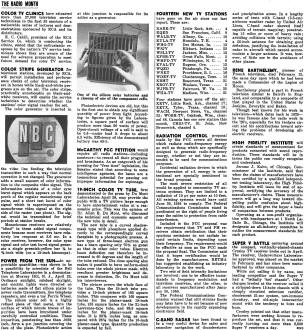The Radio Month |
|
One of the great benefits of buying and reading these vintage electronics (and other types) magazines is running across information you have read or heard about from a historical perspective, but was late-breaking contemporary news at the time of publication. Although I cannot cite a specific instance off the top of my head, there have been times when the original sources told a very different story than the one often heard in second-, third-, or fourth-hand versions far removed from the actual event. It is like a Xerox copy of a document that has been through many iterations of copies of copies of copies. This 1954 issue of Radio-Electronics magazine reports on a petition submitted to the FCC by none other than Senator Joseph McCarthy, seeking to require all radio stations, including those of amateur operators, to record their broadcasts for future review. His concern was the potential for information compromising national security being transmitted. McCarthy has been accused of - and mocked for - seeing a Communist behind every rock... at a time when there actually was a Communist behind many rocks. Today, the Communists operate in open sight. Another noteworthy item is the FCC's proposal to create laws governing standards limiting unintentional radiation. A rapidly growing use of televisions and radio was making more apparent problems of radio interference generators including motors, automobile ignition systems, poorly constructed electronics devices, and even industrial RF heating apparatus. The Radio Month
Radiation Control proposal made by the FCC covers all devices which radiate radio-frequency energy as well as those which are specifically designed to generate radio-frequency energy, whether or not they are intended to be used for communications purposes. Incidental radiation devices in which the generation of r.f. energy is unintentional are specially mentioned in the broad proposal. The most severe restriction of all would be applied to community TV antenna systems. They are limited to a radiation of 10 μV per meter at 10 feet. All existing systems would have until June 30, 1955 to comply. The Federal Communications Commission stand is predicated on the right of people living near the cables to protection from cable interference. Included in the FCC proposal was the requirement that TV and FM receivers obtain certification that their spurious emissions do not radiate beyond certain limits, depending upon their frequency. The requirement would be effective as soon as the FCC made the proposal final. The Commission said that it hopes certification would be done by the manufacturers. RETMA has suggested establishing an industry laboratory to do the work. Two sets of field intensity limitations are involved: one to be effective immediately to frequency modulation and television receivers, and the other, to all receivers manufactured after January 30, 1956. The Federal Communications Commission warned that still stricter limits may later have to be set because of new developments in the rapidly expanding electronics field. C-Band Radar has been found to be a very useful device for safer and smoother navigation of thunderstorm and precipitation areas. In a lengthy series of tests with C-band (5.5-cm) airborne weather radar by United Air Lines, C-band radar showed itself capable of terrain mapping; penetrating 15 miles or more of heavy rain; avoiding collisions with terrain; using a 22-inch antenna for obtaining good definition, justifying the installation of radar in aircraft which cannot accommodate a larger antenna. It was, however, of little use in the avoidance of other planes.
Posted March 8, 2021 |
|

